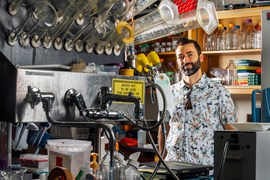Alex K. Shalek, the J. W. Kieckhefer Professor in the MIT Institute for Medical Engineering and Sciences (IMES) and Department of Chemistry, has been named the new director of IMES, effective Aug. 1.
“Professor Shalek’s substantial contributions to the scientific community as a researcher and educator have been exemplary. His extensive network across MIT, Harvard, and Mass General Brigham will be a tremendous asset as director of IMES,” says Anantha Chandrakasan, chief innovation and strategy officer, dean of the School of Engineering, and the Vannevar Bush Professor of Electrical Engineering and Computer Science. “He will undoubtedly be an excellent leader, bringing his innovative approach and collaborative spirit to this new role.”
Shalek is a core member of IMES, a professor of chemistry, and holds several leadership positions, including director of the Health Innovation Hub. He is also an extramural member of MIT’s Koch Institute for Integrative Cancer Research; a member of the Ragon Institute of Mass General, MIT, and Harvard; an institute member of the Broad Institute of MIT and Harvard; an assistant in immunology at Mass General Brigham; and an instructor in health sciences and technology at Harvard Medical School.
The Shalek Lab’s research seeks to uncover how communities of cells work together within human tissues to support health, and how they become dysregulated in disease. By developing and applying innovative experimental and computational technologies, they are shedding light on a wide range of human health conditions.
Shalek and his team use a cross-disciplinary approach that combines genomics, chemical biology, and nanotechnology to develop platforms to profile and control cells and their interactions. Collaborating with researchers across the globe, they apply these tools to study human diseases in great detail. Their goal is to connect what occurs at a cellular level with what medical professionals observe in patients, paving the way for more precise ways to prevent and treat diseases.
Over the course of his career, Shalek’s groundbreaking research has earned him widespread recognition and numerous awards and honors. These include an NIH New Innovator Award, a Beckman Young Investigator Award, a Searle Scholar Award, a Pew-Stewart Scholar Award, an Alfred P. Sloan Research Fellowship in Chemistry, and an Avant-Garde (DP1 Pioneer) Award. Shalek has also been celebrated for his dedication as a faculty member, educator, and mentor. He was awarded the 2019-20 Harold E. Edgerton Faculty Achievement Award at MIT and the 2020 HMS Young Mentor Award.
Shalek received his bachelor’s degree in chemical physics from Columbia University and his master’s and PhD in chemical physics from Harvard University. Prior to joining MIT’s faculty in 2014, he was a postdoc at the Broad Institute.
Shalek succeeds Elazer Edelman, the Edward J. Poitras Professor in Medical Engineering and Science, who has led IMES since April 2018.
“I am grateful to Professor Edelman for his incredible leadership and service to IMES over the past six years,” says Chandrakasan. “His contributions to IMES have been invaluable, and we are thankful for his dedication and vision during his tenure as director.”









